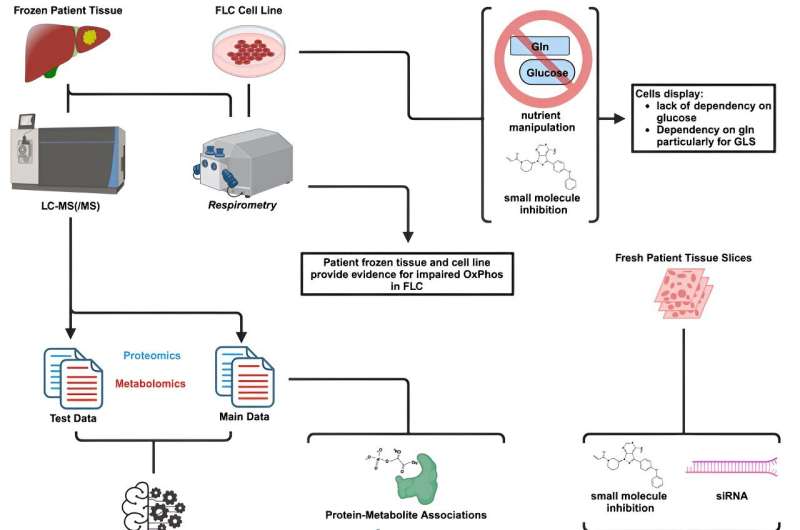This article has been reviewed according to Science X's editorial process and policies. Editors have highlighted the following attributes while ensuring the content's credibility:
fact-checked
peer-reviewed publication
trusted source
proofread
Deadly liver cancer rewires cell metabolism to grow, study finds

A deadly liver cancer that mainly affects children and young adults rewires its cellular metabolism in order to thrive, according to a new study that opens the door to exploring new targets for therapies.
Fibrolamellar carcinoma, which does not respond to conventional treatments, accounts for only 1–2% of all liver cancers, but is without standard of care and has often metastasized by the time it is detected, leaving patients with approximately a year to live on average.
While many cancers prefer glucose to promote their survival, some show dependence on other nutrients. Fibrolamellar carcinoma depends on glutamine for energy production, and also seems to place a strong emphasis on serine utilization for this purpose as well, according to the study.
"There appears to be with this cancer an impairment in metabolizing sugar and it actually seems to be very keen on amino acids, which is something that deviates from the norm in terms of what the general public typically think about cancer," said Donald Long Jr., the study's lead author, Howard Hughes Medical Institute Gilliam Fellow, and a doctoral candidate in the lab of senior author Praveen Sethupathy '03, professor of physiological genomics and chair of the Department of Biomedical Sciences in the College of Veterinary Medicine.
The paper, "Proteo-metabolomics and Patient Tumor Slice Experiments Point to Amino Acid Centrality for Rewired Mitochondria in Fibrolamellar Carcinoma," published Aug. 28 in the journal Cell Reports Medicine.
"Our findings point to specific features of the cancer that represent therapeutic vulnerabilities, and could be very useful for testing specific drug combinations," Sethupathy said.
In the study, the researchers used proteomics (to determine the spectrum of proteins in the cancer cells) and metabolomics (the spectrum of metabolites) and identified more than 8,000 proteins and 135 metabolites. They obtained frozen patient tissue samples from the Fibrolamellar Cancer Foundation Biobank and developed a predictive model based on the omics data that was generated in collaboration with co-author Lukas Orre, an associate professor at the Karolinska Institute in Sweden.
Several key aspects of the model were experimentally validated via functional studies using fresh tumor tissue slices directly from patients, in collaboration with co-author Taranjit Gujral, an associate professor at the Fred Hutchinson Cancer Center.
Under normal circumstances, the glycolytic pathway breaks down glucose to form a metabolite called pyruvate, which then enters the mitochondria (the cell's powerhouse) and is used to produce ATP, a small molecule that stores chemical energy used to power the cell's biochemical reactions.
"We saw from our analysis of the proteomic and metabolomic data, and additional experiments in a cell model of fibrolamellar carcinoma, that this pathway was impaired," Long said.
The researchers then identified a liver-specific protein, called serine dehydratase, as the 10th-most upregulated protein in the proteomics dataset. This enzyme can convert the amino acid serine into pyruvate. The pyruvate then follows the usual path into the mitochondria to produce ATP.
In tests using the fresh patient cancer tissue slices, the researchers inhibited serine dehydratase and found the cancer tissues became much less viable. A drug that blocks pyruvate entry into the mitochondria also dramatically affected the survival of the fibrolamellar cancer tissues.
The researchers also predict another use of pyruvate, where the metabolite is also employed in the production of proline. Proline is a non-essential amino acid that is integral to making collagen, the primary building block of connective tissue.
One of the hallmarks of fibrolamellar carcinoma is that its tumors have fibrous bands of collagen running through them.
"It looks like, potentially, the mitochondria is being rewired to produce copious amounts of proline, presumably to integrate into this collagen matrix that promotes the tumor's growth," Long said.
Co-authors also included Rosanna Ma and Adam Francisco in the Sethupathy lab; Nathaniel Vacanti, assistant professor, Joeva Barrow, assistant professor, and Pei-Yin Tsai, a doctoral student, all in the Division of Nutritional Sciences in the College of Human Ecology; and researchers from UCLA, the Johns Hopkins University School of Medicine and Rutgers University.
More information: Donald Long et al, Proteo-metabolomics and patient tumor slice experiments point to amino acid centrality for rewired mitochondria in fibrolamellar carcinoma, Cell Reports Medicine (2024). DOI: 10.1016/j.xcrm.2024.101699




















